Extracurricular Activities: Kathy Suprenant, quilter
Kathy Suprenant is a professor of molecular biosciences and a quilt artist.

Why do you quilt? Historically, fabric was precious, and small pieces of clothing were recycled into functional quilts. My grandmother, for example, recycled samples of men’s wool suiting material to create a warm bed quilt. So, why do I cut up perfectly good fabric, sew it together, and then turn it into a piece of wall art? That is the million-dollar question for many traditional and non-traditional quilters. Quilting, like other art forms, shares the qualities of creativity and self-expression. Also, I love the feel of fabric and the challenge of making something new.
How long have you been making art quilts? I started making art quilts around the year 2005. Smaller-sized quilts allowed greater experimentation with fabric, found objects, paper, hand stitching and beading. My recent work is inspired by the microscopic world of living cells and combines my conceptualization of cell structure and function with the traditions of quilting and surface design. Many of my traditional and nontraditional quilts can be found on my website and blog (Kathy Suprenant/), and on the Studio Art Quilt Associates website.

What’s your favorite part of quilting? I love the moment when I commit to an idea and translate this idea to fabric. Generally, I make a sketch and enlarge it by photocopying. The enlargement is placed on my design wall and I “pull” fabric from my stash to audition each fabric in order to create the balance and design that I imagined.
Does your artist side of the brain converse with the scientist part of your brain? Science is like art in many more ways that one would imagine. Recently, I was invited by the prestigious Cell Press to submit electron micrographs for the “Cell Curiosities” curated Picture Show.  Have an extracurricular, outside-of-work activity you want to share with the College? Email your info to clasnews@ku.edu.
Have an extracurricular, outside-of-work activity you want to share with the College? Email your info to clasnews@ku.edu.